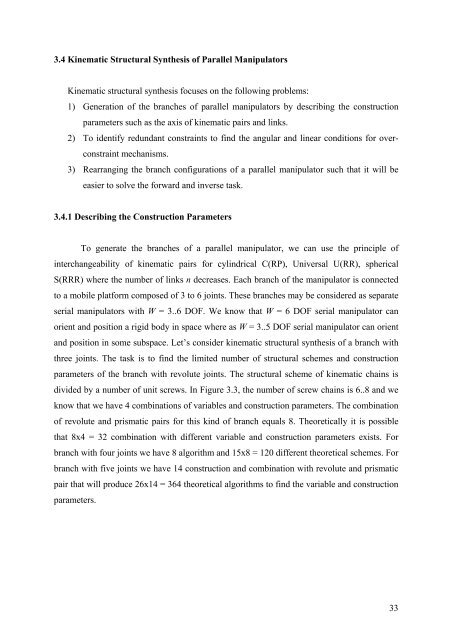Kinematic and Dynamic Analysis of Spatial Six Degree of Freedom ...
Kinematic and Dynamic Analysis of Spatial Six Degree of Freedom ...
Kinematic and Dynamic Analysis of Spatial Six Degree of Freedom ...
Create successful ePaper yourself
Turn your PDF publications into a flip-book with our unique Google optimized e-Paper software.
3.4 <strong>Kinematic</strong> Structural Synthesis <strong>of</strong> Parallel Manipulators<br />
<strong>Kinematic</strong> structural synthesis focuses on the following problems:<br />
1) Generation <strong>of</strong> the branches <strong>of</strong> parallel manipulators by describing the construction<br />
parameters such as the axis <strong>of</strong> kinematic pairs <strong>and</strong> links.<br />
2) To identify redundant constraints to find the angular <strong>and</strong> linear conditions for overconstraint<br />
mechanisms.<br />
3) Rearranging the branch configurations <strong>of</strong> a parallel manipulator such that it will be<br />
easier to solve the forward <strong>and</strong> inverse task.<br />
3.4.1 Describing the Construction Parameters<br />
To generate the branches <strong>of</strong> a parallel manipulator, we can use the principle <strong>of</strong><br />
interchangeability <strong>of</strong> kinematic pairs for cylindrical C(RP), Universal U(RR), spherical<br />
S(RRR) where the number <strong>of</strong> links n decreases. Each branch <strong>of</strong> the manipulator is connected<br />
to a mobile platform composed <strong>of</strong> 3 to 6 joints. These branches may be considered as separate<br />
serial manipulators with W = 3..6 DOF. We know that W = 6 DOF serial manipulator can<br />
orient <strong>and</strong> position a rigid body in space where as W = 3..5 DOF serial manipulator can orient<br />
<strong>and</strong> position in some subspace. Let’s consider kinematic structural synthesis <strong>of</strong> a branch with<br />
three joints. The task is to find the limited number <strong>of</strong> structural schemes <strong>and</strong> construction<br />
parameters <strong>of</strong> the branch with revolute joints. The structural scheme <strong>of</strong> kinematic chains is<br />
divided by a number <strong>of</strong> unit screws. In Figure 3.3, the number <strong>of</strong> screw chains is 6..8 <strong>and</strong> we<br />
know that we have 4 combinations <strong>of</strong> variables <strong>and</strong> construction parameters. The combination<br />
<strong>of</strong> revolute <strong>and</strong> prismatic pairs for this kind <strong>of</strong> branch equals 8. Theoretically it is possible<br />
that 8x4 = 32 combination with different variable <strong>and</strong> construction parameters exists. For<br />
branch with four joints we have 8 algorithm <strong>and</strong> 15x8 = 120 different theoretical schemes. For<br />
branch with five joints we have 14 construction <strong>and</strong> combination with revolute <strong>and</strong> prismatic<br />
pair that will produce 26x14 = 364 theoretical algorithms to find the variable <strong>and</strong> construction<br />
parameters.<br />
33
















